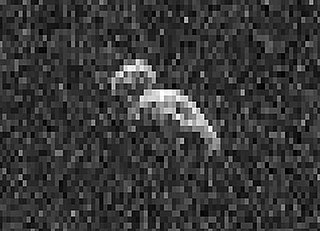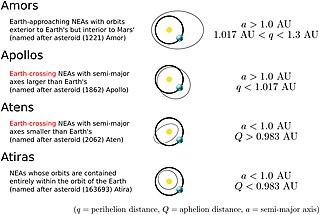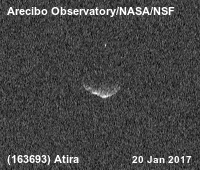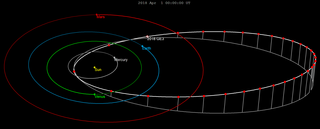
A near-Earth object (NEO) is any small Solar System body whose orbit brings it into proximity with Earth. By convention, a Solar System body is a NEO if its closest approach to the Sun (perihelion) is less than 1.3 astronomical units (AU). If a NEO's orbit crosses the Earth's orbit, and the object is larger than 140 meters (460 ft) across, it is considered a potentially hazardous object (PHO). Most known PHOs and NEOs are asteroids, but a small fraction are comets.

The Aten asteroids are a dynamical group of asteroids whose orbits bring them into proximity with Earth. By definition, Atens are Earth-crossing asteroids (a < 1.0 AU and Q > 0.983 AU). The group is named after 2062 Aten, the first of its kind, discovered on 7 January 1976 by American astronomer Eleanor Helin at Palomar Observatory. As of November 2023, 2,646 Atens have been discovered, of which 256 are numbered, 14 are named, and 102 are classified as potentially hazardous asteroids.

The Amor asteroids are a group of near-Earth asteroids named after the archetype object 1221 Amor. The orbital perihelion of these objects is close to, but greater than, the orbital aphelion of Earth, with most Amors crossing the orbit of Mars. The Amor asteroid 433 Eros was the first asteroid to be orbited and landed upon by a robotic space probe.

2062 Aten, provisional designation 1976 AA, is a stony sub-kilometer asteroid and namesake of the Aten asteroids, a subgroup of near-Earth objects. The asteroid was named after Aten from Egyptian mythology.
2101 Adonis, provisional designation: 1936 CA, is an asteroid on an extremely eccentric orbit, classified as potentially hazardous asteroid and near-Earth object of the Apollo group. Adonis measures approximately 1 kilometer in diameter. Discovered by Eugène Delporte at Uccle in 1936, it became a lost asteroid until 1977. It may also be an extinct comet and a source of meteor showers. It was named after Adonis from Greek mythology.

163693 Atira (; provisional designation 2003 CP20) is a stony asteroid, dwelling in the interior of Earth's orbit. It is classified as a near-Earth object. Atira is a binary asteroid, a system of two asteroids orbiting their common barycenter. The primary component with a diameter of approximately 4.8 kilometers (3 miles) is orbited by a minor-planet moon that measures about 1 km (0.6 mi). Atira was discovered on 11 February 2003, by astronomers with the Lincoln Near-Earth Asteroid Research at Lincoln Laboratory's Experimental Test Site near Socorro, New Mexico, in the United States.

367943 Duende (provisional designation 2012 DA14) is a micro-asteroid and a near-Earth object of the Aten and Atira group, approximately 30 meters (98 ft) in diameter. It was discovered by astronomers of the Astronomical Observatory of Mallorca at its robotic La Sagra Observatory in 2012, and named for the duende, a goblin-like creature from Iberian and Filipino mythology and folklore. Duende is likely an uncommon L-type asteroid and significantly elongated. For an asteroid of its size, it has a relatively long rotation period of 9.485 hours.

The Chelyabinsk meteor was a superbolide that entered Earth's atmosphere over the southern Ural region in Russia on 15 February 2013 at about 09:20 YEKT. It was caused by an approximately 18 m (59 ft) diameter, 9,100-tonne (10,000-short-ton) near-Earth asteroid that entered the atmosphere at a shallow 18.3 ± 0.4 degree angle with a speed relative to Earth of 19.16 ± 0.15 kilometres per second. The light from the meteor was briefly brighter than the Sun, visible as far as 100 km (60 mi) away. It was observed in a wide area of the region and in neighbouring republics. Some eyewitnesses also reported feeling intense heat from the fireball.
2011 EO40 is an asteroid, classified as a near-Earth object and a potentially hazardous asteroid of the Apollo group. It is a possible candidate for the parent body of the Chelyabinsk superbolide.
2017 DR109, is a micro-asteroid, classified as near-Earth object of the Apollo group and Aten group, respectively. It is currently trapped in a 1:1 mean motion resonance with the Earth of the horseshoe type. The object was first observed on 27 February 2017, by astronomers of the Catalina Sky Survey conducted at Mount Lemmon Observatory, Arizona, United States.

2017 VL2 is a micro-asteroid, classified as a near-Earth object of the Apollo group. It was first observed by ATLAS at Mauna Loa Observatory on 10 November 2017, a day after it passed inside the orbit of Earth.

2017 OO1 is a small asteroid, classified as near-Earth object of the Aten group, approximately 35–76 meters (115–249 feet) in diameter. It was first observed on 23 July 2017, by the robotic ATLAS survey at Mauna Loa Observatory, Hawaii, two days after the object had approached Earth at 0.33 lunar distances on 21 July 2017.

2018 DV1 is a micro-asteroid, classified as a near-Earth object of the Aten group, approximately 6–12 meters (20–40 feet) in diameter. It was first observed on 26 February 2018, by astronomers of the Mount Lemmon Survey at Mount Lemmon Observatory, Arizona, five days prior to its sub-lunar close encounter with Earth at less than 0.3 lunar distance.

2017 VR12 is a sub-kilometer asteroid with a somewhat elongated and angular shape, approximately 160 meters (500 feet) in diameter. It is classified as near-Earth object and potentially hazardous asteroid of the Apollo or Amor group. The V-type asteroid has a rotation period of approximately 1.5 hours. It was first observed on 10 November 2017 by the 60-inch Pan-STARRS 1 telescope at Haleakala Observatory in Hawaii.

2018 GE3 is a sub-kilometer asteroid on a highly eccentric orbit, classified as a near-Earth object of the Apollo group, approximately 48–110 meters (160–360 feet) in diameter. It was first observed on 14 April 2018, by astronomers with the Catalina Sky Survey one day prior to its sub-lunar close encounter with Earth at 0.5 lunar distance. It is one of the largest known asteroids (possibly the largest) in observational history to ever pass that close to Earth (also see list).
2019 UN13 is a small near-Earth asteroid roughly 1–2 meters in diameter. Even though the asteroid was in the night sky for months, it was fainter than the sky survey limit of apparent magnitude 24 until 29 October 2019 when the asteroid was two million km from Earth. It was discovered on October 31, 2019, passing 6,200 km above Earth's surface.
2020 VT4 is a tiny near-Earth asteroid that passed 370 km (230 mi) above Earth's surface on 13 November 2020 at 17:20 UTC. The asteroid was discovered by the Asteroid Terrestrial-impact Last Alert System (ATLAS) survey at the Mauna Loa Observatory fifteen hours after its closest approach to Earth. The Earth encounter perturbed the asteroid's trajectory from an Earth-crossing Apollo-type orbit to an Aten-type orbit, subsequently reducing the asteroid's heliocentric orbital period from 1.5 years to 0.86 years.
2020 SW is a tiny near-Earth asteroid discovered by the Mount Lemmon Survey on 18 September 2020, six days before it made its closest approach to Earth. The asteroid passed within 21,600 kilometres (13,400 mi) from Earth's surface on 24 September 2020 11:13 UT, within the geostationary altitude of 36,000 kilometres (22,000 mi). The encounter with Earth perturbed the asteroid's heliocentric trajectory from an Apollo-type orbit to an Aten-type orbit with a semi-major axis within one astronomical unit from the Sun. As a result, the asteroid will not make any close approaches to Earth within 0.01 astronomical units (4 LD) in the next 200 years.











